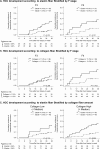Elastin Fiber Accumulation in Liver Correlates with the Development of Hepatocellular Carcinoma
- PMID: 27128435
- PMCID: PMC4851385
- DOI: 10.1371/journal.pone.0154558
Elastin Fiber Accumulation in Liver Correlates with the Development of Hepatocellular Carcinoma
Erratum in
-
Correction: Elastin Fiber Accumulation in Liver Correlates with the Development of Hepatocellular Carcinoma.PLoS One. 2016 Aug 15;11(8):e0160133. doi: 10.1371/journal.pone.0160133. eCollection 2016. PLoS One. 2016. PMID: 27526177 Free PMC article.
Abstract
Background & aims: The fibrosis stage, which is evaluated by the distribution pattern of collagen fibers, is a major predictor for the development of hepatocellular carcinoma (HCC) for patients with hepatitis C. Meanwhile, the role of elastin fibers has not yet been elucidated. The present study was conducted to determine the significance of quantifying both collagen and elastin fibers.
Methods: We enrolled 189 consecutive patients with hepatitis C and advanced fibrosis. Using Elastica van Gieson-stained whole-slide images of pretreatment liver biopsies, collagen and elastin fibers were evaluated pixel by pixel (0.46 μm/pixel) using an automated computational method. Consequently, fiber amount and cumulative incidences of HCC within 3 years were analyzed.
Results: There was a significant correlation between collagen and elastin fibers, whereas variation in elastin fiber was greater than in collagen fiber. Both collagen fiber (p = 0.008) and elastin fiber (p < 0.001) were significantly correlated with F stage. In total, 30 patients developed HCC during follow-up. Patients who have higher elastin fiber (p = 0.002) in addition to higher collagen fiber (p = 0.05) showed significantly higher incidences of HCC. With regard to elastin fiber, this difference remained significant in F3 patients. Furthermore, for patients with a higher collagen fiber amount, higher elastin was a significant predictor for HCC development (p = 0.02).
Conclusions: Computational analysis is a novel technique for quantification of fibers with the added value of conventional staging. Elastin fiber is a predictor for the development of HCC independently of collagen fiber and F stage.
Conflict of interest statement
Figures





References
-
- Kanwal F, Hoang T, Kramer JR, Asch SM, Goetz MB, Zeringue A, et al. Increasing prevalence of HCC and cirrhosis in patients with chronic hepatitis C virus infection. Gastroenterology. 2011;140(4):1182–8 e1. Epub 2010/12/28. doi: S0016-5085(10)01877-9 [pii] 10.1053/j.gastro.2010.12.032 - DOI - PMC - PubMed
-
- Masseroli M, Caballero T, O'Valle F, Del Moral RM, Perez-Milena A, Del Moral RG. Automatic quantification of liver fibrosis: design and validation of a new image analysis method: comparison with semi-quantitative indexes of fibrosis. J Hepatol. 2000;32(3):453–64. Epub 2000/03/29. doi: S0168827800803979 [pii]. . - PubMed
Publication types
MeSH terms
Substances
LinkOut - more resources
Full Text Sources
Other Literature Sources
Medical
Miscellaneous

